Wooden Balls (15th – 17th Century) : In the earliest days of golf, dating back to the 15th century in Scotland, players used balls made from wood. These early balls were handcrafted, typically from hardwoods like beech or ash. While functional, they were not durable and didn’t travel far or consistently.
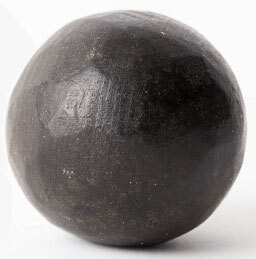
Featherie Golf Balls: In the 16th century, a major improvement came with the introduction of the "featherie" ball. This was a leather pouch filled with feathers (usually goose feathers), sewn together and stitched tight. The leather exterior was often dyed in various colours. The ball was then shaped and hand-sewn into a round shape. Featheries were much better than wood, but they were expensive, and they tended to get damaged quickly, especially when wet. The ‘feathery’ or ‘featherie’ golf ball dominated golf for over 200 years, was the making of golf on the links.
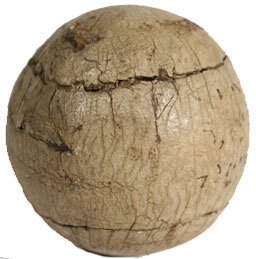
The Gutty Ball (Late 19th Century)
From 1848, golf balls made of gutta-percha gum, called ‘gutties’ began to replace featheries. Several claims are made about the origin of the gutty.
Gutta-Percha Balls: The "gutty" ball marked a major shift in golf ball technology. Made from the sap of the Gutta-percha tree (native to Southeast Asia), the gutty ball was far more durable and affordable than the featherie. It was solid and had a smooth surface, and it could withstand more abuse (more durable), including hitting hard surfaces and moisture.
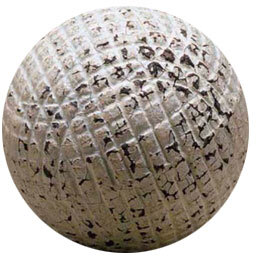
Improvement in Design: In the 1870s, golfers began to notice that balls with slight surface imperfections (such as scratches or nicks) travelled farther and more consistently than smooth balls. This led to the first "dimpled" golf balls, where manufacturers intentionally added indentations to the ball’s surface.
Haskell golf balls: Coburn Haskell, an American, developed a wound core ball in 1898. In 1899, he and Bertram Work, an employee of the Goodrich rubber company in Ohio, patented the Haskell ball, as it came to be known, in 1899 – a solid core wrapped tightly with rubber threads covered with a layer of gutta-percha.
The ball arrived in Britain in 1900, but in 1905 Haskell’s patent in UK was refused on the grounds of prior existence from 1870. This means that for different reasons, none of the golf balls which were the making of golf were patented in the UK.
The hand winding of the rubber threads was soon mechanized. The outside covering was initially a Bramble pattern, and it would be a dozen years before superior dimples patterns that we know today were developed.
Bobby Jones described this as the most important development in golf, and it certainly was of his life time. Within a few years, the Haskell was outperforming the gutty and superseded it
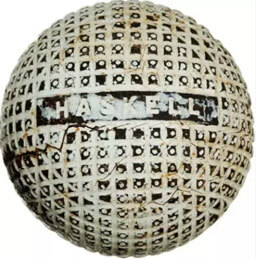
The 20th Century Golf Balls
Rubber Core (Early 1900s): By the early 20th century, the introduction of rubber cores revolutionized the golf ball. The rubber-core ball, typically wrapped in a rubber thread and encased in a solid rubber or synthetic cover, replaced the solid gutta-percha ball. These balls had better elasticity, which allowed for greater distance and control.
The First Patent for a Dimpled Ball (1905): The dimpled ball was patented by William Taylor in 1905, although variations had existed informally before that. The dimples created more lift and less drag, enabling the ball to fly farther. This innovation was a key advancement that would change the game forever.
Surlyn and Urethane Covers (Late 1900s): As golf technology advanced, the materials used for the ball covers evolved. In the 1960s and 1970s, manufacturers began experimenting with materials like Surlyn (a durable plastic) for the outer layer of the ball. This made the balls more resilient and offered players a better feel. Urethane covers, which are softer and provide better spin control, were introduced in the 1980s, primarily for high-end, tour-level balls.
.

Modern Golf Balls (Late 20th Century to Present)
Though the first 2-piece ball with solid core and cover, was developed in 1902, it would be decades before the Haskell ball was replaced. In 1967, Spalding re-devised this construction using Suralyn as cover. Since then, there has been a never ending explosion of 1, 2 and 3 piece developments of cores with variations of covers and dimples. The result is golf balls than spin slower off the driver, and hence slice less, but still allow control in short game.
Multi-Layer Balls: Modern golf balls are typically made up of multiple layers (two to five layers), each with a specific purpose. The core may be made of rubber or a synthetic material that maximizes energy transfer (distance), while the outer layers control the ball’s spin and feel. The combination of these layers gives golfers a variety of performance options based on their skill level and playing style.
Technological Refinements: In the 1990s and 2000s, manufacturers like Titleist, Callaway, and TaylorMade led the charge in refining golf ball designs, integrating advanced materials and aerodynamics. Balls became more customizable, allowing players to choose from balls optimized for distance, control, or a balance of both.
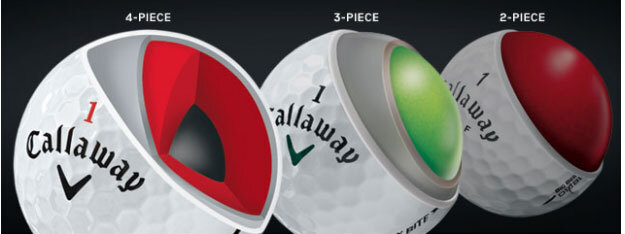
Titleist ProV1 - The most successful golf ball over the past 25+ years
It was in October of 2000, at the PGA TOUR’s Invensys Classic in Las Vegas that the original Pro V1 was first made available to play in competition. Forty-seven players – including the eventual champion Billy Andrade made the immediate move to Pro V1 that week.
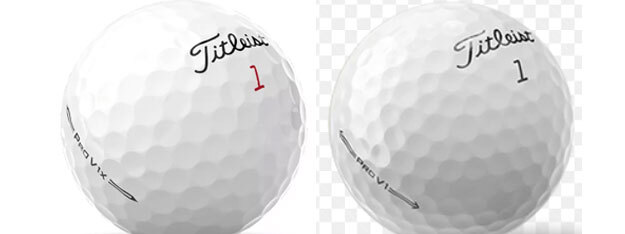
Summary of Key Golf Ball Innovations:
15th-17th Century: Wooden balls, followed by featherie balls made of leather and feathers.
1840s: Gutta-percha balls, durable and cost-effective.
Early 1900s: Haskell superseded the gutty with ‘wound’ technology
1960s-1970s: Surlyn covers became standard for mass-produced balls.
1980s-present: Urethane covers for better spin and feel; multi-layer designs for optimized performance.
From 2028: New golf ball rules: R&A and USGA opt to limit distance golf balls will travel in air.
The new measures come into force in January 2028 for the elite game, with a phased introduction for recreational golfers in 2030.
From its humble wooden beginnings to the highly engineered, multi-layered marvels of today, the golf ball has evolved in tandem with the game itself, becoming a crucial element of modern golf performance.
